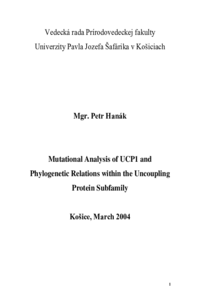Mutational Analysis of UCP1 and Phylogenetic Relations within the Uncoupling Protein Subfamily
Mutační analýza UCP1 a fylogenetické vztahy v podrodině odpřahujících proteinů
rigorózní práce (UZNÁNO)

Zobrazit/
Trvalý odkaz
http://hdl.handle.net/20.500.11956/58259Identifikátory
SIS: 128029
Kolekce
- Kvalifikační práce [19589]
Autor
Fakulta / součást
Přírodovědecká fakulta
Obor
Biochemie
Katedra / ústav / klinika
Katedra biochemie
Datum obhajoby
11. 10. 2012
Nakladatel
Univerzita Karlova, Přírodovědecká fakultaJazyk
Angličtina
Známka
Uznáno
V teoretické části disertační práce bylo provedeno hledání nových homologů doposud známých UCP - byli tedy vyhledáváni noví členové UCP rodiny. Nové UCP byly nalezeny u octomilky (Drosophila melanogaster)(čtyři nové UCP), jedno u hlístice Caenorhabditis elegans, jedno v modelovém organismu Dictyostelium discoideum a jedno UCP v rostlině huseníčku rolním (Arabidopsis thaliana). Sestrojené dendrogramy umístily dříve známé a tyto nově anotované UCP do dvou hlavních skupin - "klastru UCP4" (kam patří krom UCP4 a BMCP/UCP5 všechna nově identifikovaná UCP) a "klasický" klastr, zahrnující UCP1, 2, 3 a všechna PUMP. Zřetelná všudypřítomnost UCP4 v organismech živočišné říše by mohla ukazovat na jeho roli jako ancestrálního UCP. V experimentální části disertační práce byla studována role vybraných aminokyselinových zbytků pro protonový transport (a také pro transport chloridových aniontů) a pro vazbu regulačních nukleotidů. Byly zkonstruovány tři mutanty UCP1 v oblasti prvního α-helixu (D27V, T30A and C24A-D27V-T30A) a dvě UCP s mutací v oblasti druhého matrixového úseku (H145L-H147L and R152L). Tyto mutantní UCP1 byly následně exprimovány a inkorporovány do proteolipozómů obsahujících indikátory H+ nebo Cl- . Obdobným postupem byly připraveny také proteolipozómy s nemutovaným UCP1 "divokého typu". Naměřené...
ln theoretical part search for new homologs of known UCPs, thus for new members of UCP subfamily was carried out. New UCPs were found in Drosophila melanogaster (four UCP species), one in nematode Caenorhabditis elegans, one in model organism - soil amoeba belonging lo Protists (Protista) Dictyostelium discoideum and one new UCP in plant Arabidopsis thaliana. Constructed phylogenetic tree grouped previously known and newly annotated UCPs into two main groups - "UCP4 cluster" (into which belong besides UCP4 and BMCP/UCP5 all newly uncovered UCP species) and "classical" one comprising UCP1, 2, 3 and PUMPs. Apparent widespread presence of UCP4 type uncoupling proteins throughout the whole animal kingdom might support its role as an ancestor in UCP evolution. In experimental part of the dissertation importance of particular amino acid residues for proton (and also Cl- ) transport as well as for binding of regulatory NPs was studied. Three UCP1 mutants from the 1st α-helix (D27V, T30A and C24A-D27V- T30A) and two from the second matrix segment (H145L-H147L and R152L) were constructed, expressed and incorporated into proteoliposomes with entrapped H+ and Cl- indicator. By the same procedure proteoliposomes with wild type UCP1 were prepared. The transport properties of wt UCP1 were in agreement with the...
